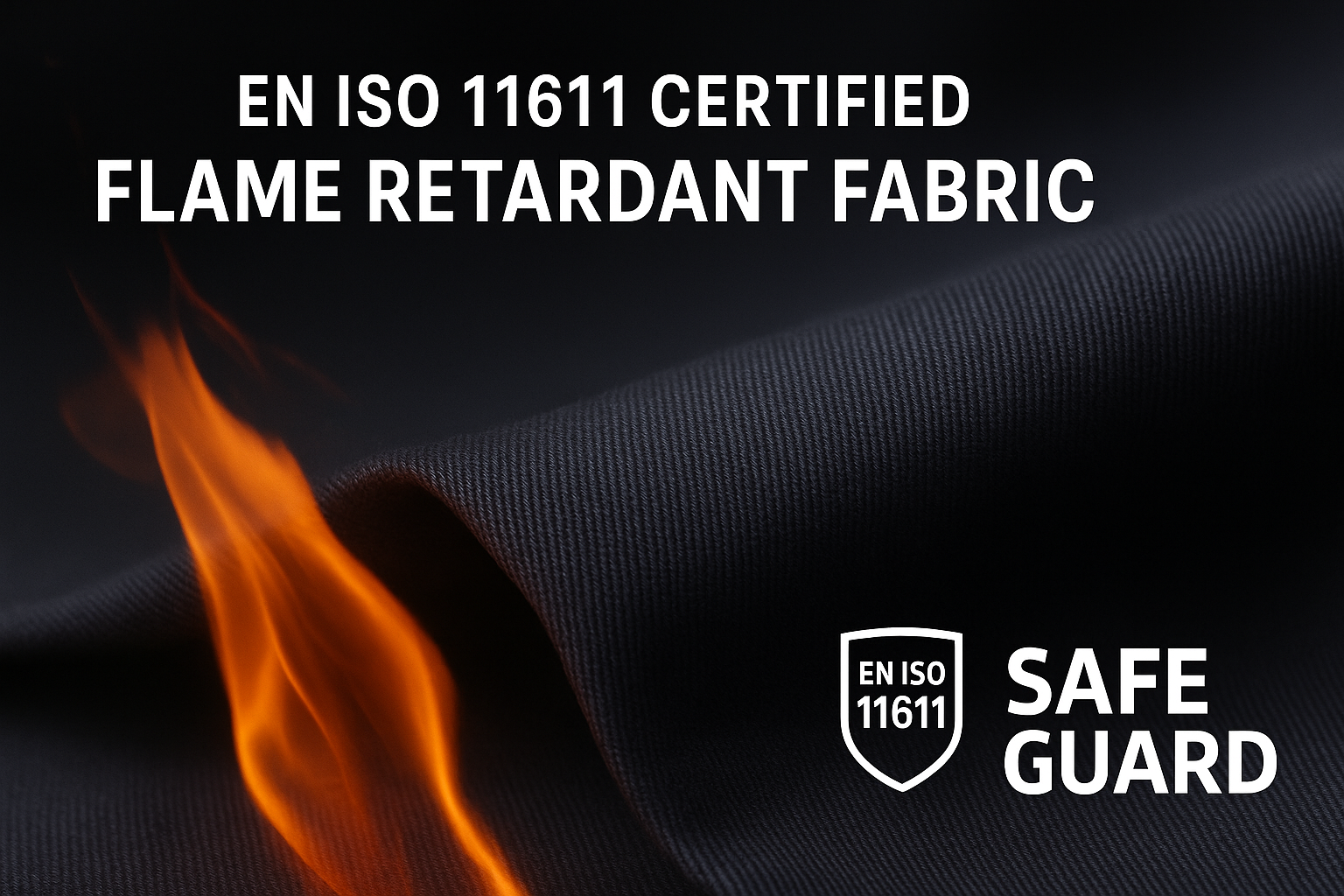Welding workwear faces some of the harshest industrial conditions — sparks, molten metal, and intense radiant heat.
To protect workers from these hazards, fabrics must meet the EN ISO 11611 standard — the globally recognized benchmark for welding protective clothing.
At SAFE GUARD, we manufacture premium EN11611 fabrics that combine comfort, durability, and certified flame retardant protection.
Our product range includes 100% cotton,CVC, and nylon/cotton fabrics designed to meet both Class 1 and Class 2 protection levels.
1. What Is EN ISO 11611?
EN ISO 11611 sets minimum performance requirements for protective clothing used in welding and allied processes. It evaluates a fabric’s resistance to flame, molten metal splash, and radiant heat so you can trust garments to protect workers in hazardous environments.
| Class | Application | Protection Level |
|---|---|---|
| Class 1 | Light welding or cutting (low spatter/radiant heat) | Basic flame and heat protection |
| Class 2 | Heavy welding, grinding (high spatter/radiant heat) | Advanced protection for higher risk work |
2. EN ISO 11611 Fabric Testing Methods
EN ISO 11611 requires laboratory tests that measure flame spread, molten metal splash resistance, and radiant heat performance. Below are the core methods and minimum requirements.
2.1 Flame Spread Resistance (ISO 15025)
Purpose: Evaluate how fabric reacts when exposed to a small flame and whether it self-extinguishes without forming holes or molten droplets.
Method: Apply a 38 mm gas flame to the sample for either 10 seconds (Procedure A) or 10 seconds (Procedure B). Record afterflame, afterglow and inspect for holes, melting, or debris.
| Procedure | Ignition Type | Fabric Type | Flame Exposure | Pass Requirements |
|---|---|---|---|---|
|
Procedure A |
Surface ignition |
Thin / single-layer (≤1 mm) |
10 s |
-Afterflame ≤ 2 s;
-Afterglow ≤ 2 s; -No hole,melting/dripping and top-edge flame spread; |
|
Procedure B |
Edge ignition |
Thick / multilayer (>1 mm) |
10 s |
-Afterflame ≤ 2 s;
-Afterglow ≤ 2 s; -No hole,melting/dripping and top-edge flame spread; |
Note: When a fabric passes both A and B, you can label it A1 + A2, which demonstrates
reliable protection under varied welding exposures.
2.2 Molten Metal Splash (ISO 9150)
Purpose: To simulate the protective capability against molten metal droplets during welding.
Method: Molten aluminum is dropped from a specified height onto the fabric surface, and the number of drops before the backside temperature rises by 40°C is recorded.
| Class | Exposure Level | Minimum Requirement |
|---|---|---|
| Class 1 | Light welding | ≥ 15 drops |
| Class 2 | Heavy-duty welding | ≥ 25 drops |
A higher number means better protection against molten metal splashes — a key safety factor in welding garments.
2.3 Radiant Heat (ISO 6942, Method B)
Purpose:To test the fabric’s resistance to radiant heat.
Method:Radiant heat testing records RHTI 24 — the seconds until the back side temperature rises by 24°C under a 20 kW/m² source.
| Class | RHTI 24 Requirement | Protection performance description |
|---|---|---|
| Class 1 | RHTI 24 ≥ 7 s | Basic protection against radiant heat |
| Class 2 | RHTI 24 ≥ 16 s | High-intensity protection against radiant heat |
Optional: ISO 12127-1 (Contact Heat) is not mandatory under EN11611 but often used when also certifying to EN ISO 11612.
2.4 Contact Heat (ISO 12127-1)
-
Purpose: To determine how long the fabric can resist direct contact with a hot surface.
-
Test Method: A heated plate at 250°C is pressed against the fabric.
The time until the inner side temperature increases by 10°C is recorded.
| Class | Minimum Time | Description |
|---|---|---|
| Class 1 | ≥ 5 seconds | Light-duty welding |
| Class 2 | ≥ 10 seconds | Heavy-duty welding |
2.5 Dimensional Change (ISO 5077 / ISO 6330)
-
Purpose: To ensure the fabric maintains size and performance after washing.
-
Requirement: Shrinkage ≤ ±3% after 5 washes at 60°C.
2.6 Mechanical Strength (ISO 13934-1 / ISO 13937-2)
-
Purpose: To verify that the fabric is strong enough to withstand stress during use.
-
Requirement:
-
Tensile strength ≥ 400 N (warp/weft)
-
Tear strength ≥ 15 N
-
2.7 Electrical Conductivity (EN 1149-2) – Optional
-
Purpose: For antistatic or blended fabrics.
-
Requirement: Fabric surface must not be electrically conductive, ensuring spark safety.
2.8 Summary of Core EN ISO 11611 Test Requirements
| Test Item | Standard | Requirement (Class 1) | Requirement (Class 2) | Purpose |
|---|---|---|---|---|
| Limited Flame Spread | ISO 15025 | Must pass (A1 or A2) | Must pass (A1 or A2) | Prevents burning and hole formation |
| Molten Metal Splash | ISO 9150 | ≥ 15 drops | ≥ 25 drops | Resistance to molten metal droplets |
| Radiant Heat | ISO 6942 | ≥ 7s | ≥ 16s | Protection against radiant heat |
| Contact Heat | ISO 12127-1 | ≥ 5s | ≥ 10s | Resistance to hot surface contact |
| Dimensional Change | ISO 5077 / ISO 6330 | ≤ ±3% | ≤ ±3% | Dimensional stability after washing |
| Tensile & Tear Strength | ISO 13934-1 / ISO 13937-2 | ≥ 400N / ≥15N | ≥ 400N / ≥15N | Mechanical durability |
| Electrical Conductivity | EN 1149-2 (optional) | Non-conductive | Non-conductive | Antistatic property |
3. SAFE GUARD Fabric Options for EN ISO 11611 Protective Clothing
We produce tested and certified fabrics to meet a variety of garment needs. Choose the right composition for balance between comfort and protection.
Click here to view our product certificates.SAFE-GUARD holds the fabric certificate issued by the authoritative testing institution AITEX.
| Fabric Type | Composition | Features | Applications |
|---|---|---|---|
| 100% Cotton FR | 100% Cotton (Permanent FR treatment) | Soft, breathable, comfortable | Welding jackets, coveralls |
| CVC FR | 60% Cotton / 40% Polyester or 80%Cotton 20% Polyester | Good hand-feel, wash stability,colorfast,cost-effective | Multi-risk protective garments |
| Nylon/Cotton FR | 88% Cotton 12% Nylon | Higher abrasion resistance | Heavy-duty PPE |
| Antistatic FR | FR fabric + conductive yarn | Reduce static, safe in ESD environments | Petrochemical, electrical sectors |
4. Why EN ISO 11611 Certification Matters
EN11611 certification gives manufacturers and buyers confidence that fabrics perform consistently under welding hazards. It reduces workplace risk and increases product credibility. For Europe, EN marking remains the benchmark; internationally, refer to ISO updates.
5. Differences Between EN ISO 11611 and ISO 11611
ISO 11611 is an international standard issued by the International Organization for Standardization (ISO).
EN ISO 11611 is the European version adopted by the European Committee for Standardization (CEN).
ISO(International Standards Organisation) published the revised standard as ISO 11611:2024.
CEN(European Standards)voted against it.CEN has maintained EN ISO 11611:2015 as the current European version.
The main difference is a new artificial UV test for fabrics.
We will discuss the differences between EN ISO 11611:2015 and ISO 11611:2024 in detail in our next article.
6. Conclusion
EN11611 fabric ensures practical protection for welders against sparks, molten metal, and radiant heat. SAFE GUARD produces certified, durable, and comfortable FR fabrics to meet both Class 1 and Class 2 needs. If you need samples, technical datasheets, or bulk quotations, we are ready to help.
Reference / External Resources:



